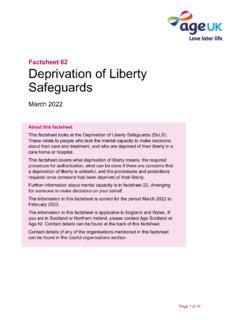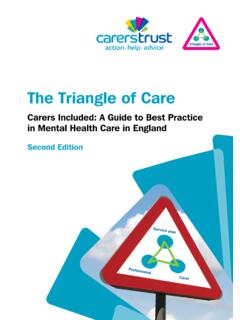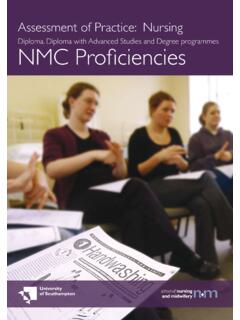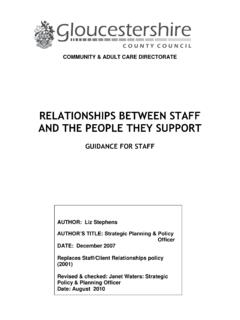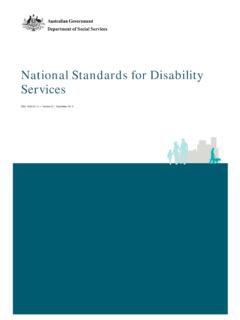Transcription of Paying for care and support at home - Age UK
1 Factsheet 46. Paying for care and support at home May 2021. About this factsheet This factsheet explains charging for social care services in places other than care homes, mainly related to services provided in your own home . It also covers charging for carers' services . This factsheet describes how you can be deemed to be a self-funder following a financial assessment . This means you are expected to fully fund the care services to meet your needs. The information in this factsheet is correct for the period May 2021 to April 2022. Benefit rates are reviewed annually and take effect in April but rules and figures can sometimes change during the year. The information in this factsheet is applicable in England. If you are in Scotland, Wales, or Northern Ireland, please contact Age Scotland, Age Cymru, or Age NI for their version of this factsheet.
2 Contact details can be found at the back of this factsheet. Contact details for any of the organisations mentioned in this factsheet can be found in the Useful organisations section. Page 1 of 22. Contents 1 Recent developments 4. 2 Sources and terms used in this factsheet 4. 3 How to access local authority services 4. The range of services available 5. assessment for care and support 5. Eligibility criteria for services 6. Self-funders' right to request' service provision 6. 4 Local authority charging rules 7. Local authority charging discretion 7. Only the service user should be charged 8. Written record of charging decisions 8. Income protection principle 8. Social security benefits 9. Disability-related expenditure 10. Disregarded income 11. Capital and maximum charges 12.
3 Disregarded capital 12. 5 Deliberate deprivation of assets 13. 6 Your personal budget 13. Direct payments 14. 7 home repairs, adaptations and equipment 15. 8 services that should be provided free of charge 16. 9 Free mental health after- care ' services 17. 10 Charging for carers' services 17. 11 Charges for respite care 18. 12 Supporting People programme 18. 13 Information, advice and advocacy duty 18. 14 Complaints 19. Age UK factsheet 46 May 2021. Paying for care and support at home Page 2 of 22. Safeguarding from abuse and neglect 19. Useful organisations 20. Age UK 21. support our work 21. Age UK factsheet 46 May 2021. Paying for care and support at home Page 3 of 22. 1 Recent developments Local Authority Circular (DHSC) (2021)1, published in January 2021, kept all rates and financial thresholds for care and support charging at the same levels as the previous financial year.
4 2 Sources and terms used in this factsheet care Act 2014, charging regulations and statutory guidance This factsheet is based on the care Act 2014 ( the Act'), introduced in April 2015. Relevant regulations are the care and support (Charging and assessment of Resources) Regulations 2014 ('the charging regulations'). Another reference source is the care and support Statutory Guidance ('the guidance'). These set out in detail how a local authority must administer adult social care . Section 8 of the statutory guidance deals with Charging and financial assessment ' and there are also annexes covering: Annex B: Treatment of capital Annex C: Treatment of income Annex E: Deprivation of assets Local authority In this factsheet, 'local authority' refers to the adult social services department of the local authority or council.
5 It is used to describe similar departments within: a county council, a district council for an area in which there is no county council, a London borough council, or the Common Council of the City of London. 3 How to access local authority services If you have difficulty managing at home , you can ask the local authority for a needs assessment . Another person such as your carer, GP, or district nurse can make a referral on your behalf with your permission. Carers can ask for a separate assessment of their support needs. If you are in hospital, the professionals working on your ward may need to arrange social care services with you prior to discharge to ensure you are safe and properly supported at home or to meet your rehabilitation needs. Staff should involve you as much as you want in the planning of your care and support .
6 In this factsheet, we focus on services you can receive outside of a care home , but residential care may be another option to meet your needs. See factsheet 29, Finding, choosing and funding a care home for more information about your choices here. Age UK factsheet 46 May 2021. Paying for care and support at home Page 4 of 22. The range of services available There are a wide range of social care services that can be provided to help you stay in your own home and assist your carer, including: domiciliary or home care and personal assistants meals delivered to your home day-centre attendance and respite care live-in care services rehabilitation services counselling direct payment support information, brokerage, and advice services specialist disability equipment adaptations to your home community alarms and other types of assistive technology.
7 Other non-residential care services include the provision of specially designed or adapted sheltered accommodation, known as supported living, warden controlled, or extra- care accommodation. Shared lives accommodation is where you move in with, or regularly visit, a carer in a long-term arrangement. Other housing options may be available, for example, designed to wheelchair access standards. A local authority has a broad discretion about how to meet your needs and how to support you and your carer if you have one. The local authority may directly provide services , or they may commission their provision externally, for example, via a care home agency. For more information, see information guide 17, Adapting your home , factsheet 6, Finding help at home , factsheet 42, Disability equipment and home adaptions and factsheet 64, Specialist housing for older people.
8 assessment for care and support The first step in getting help is to ask the local authority to carry out a needs assessment . This is how they find out what sort of help and support you need and if you meet the required eligibility criteria. Your carer can request a separate assessment of their support needs. The local authority must carry out an assessment if it appears that you may have needs for care and support . This duty applies regardless of your level of need, or the amount of money you have. Someone from the local authority, such as a social worker, usually visits to discuss your needs and decide with you what actions should be taken. The assessment must be suitable for your particular requirements. It must include any needs already met, for example by a family carer.
9 Age UK factsheet 46 May 2021. Paying for care and support at home Page 5 of 22. You can have as much involvement in this process as you want and can self-assess in some circumstances. Your needs should be recorded and you have a right to a copy of the assessment once completed. If the local authority arranges your care , they must prepare a care and support plan, involving you as much as you wish, setting out how your needs will be met. You have a right to a copy of the plan. If you have a carer, they may be entitled to a support plan after a carer's assessment . A care and support plan must describe: outcomes you wish or need to achieve what your assessed eligible needs are which eligible needs the local authority will meet and how they will meet them information and advice on preventing, reducing, or delaying future needs your personal budget figure, and details of any direct payments that are agreed.
10 A personal budget is the overall amount the local authority calculates it will cost to meet your eligible needs. It tells you how much you must pay towards this following a financial assessment and the remaining amount the local authority must pay to ensure your needs are met (see section 6). Eligibility criteria for care and support To be eligible for help from the local authority, you must be assessed as being unable to achieve certain things ( outcomes') in your daily life, or have difficulty with them, and this has a significant impact on your wellbeing. If you are assessed as having eligible needs, the local authority has a legal duty to ensure they are met. It can charge you for most services intended to meet this duty. This is different to NHS services , which are largely free at the point of delivery.





